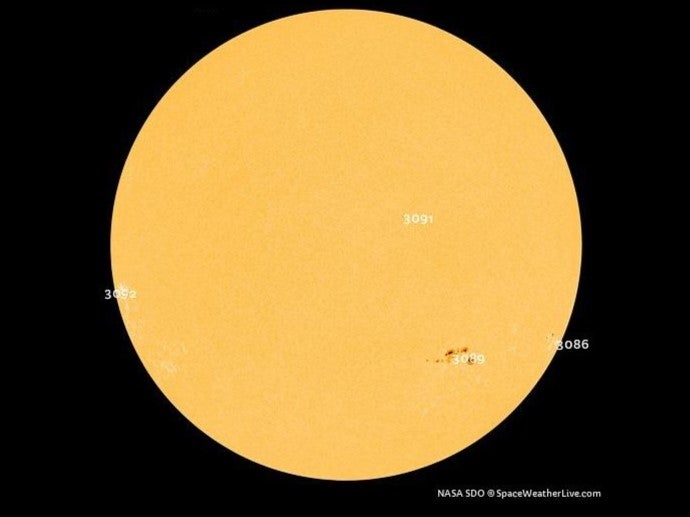Giant sunspot risks blasting Earth with powerful solar flares
Geomagnetic storm from Sunspot 3089 would cause stunning auroras but could damage infrastructure

Your support helps us to tell the story
From reproductive rights to climate change to Big Tech, The Independent is on the ground when the story is developing. Whether it's investigating the financials of Elon Musk's pro-Trump PAC or producing our latest documentary, 'The A Word', which shines a light on the American women fighting for reproductive rights, we know how important it is to parse out the facts from the messaging.
At such a critical moment in US history, we need reporters on the ground. Your donation allows us to keep sending journalists to speak to both sides of the story.
The Independent is trusted by Americans across the entire political spectrum. And unlike many other quality news outlets, we choose not to lock Americans out of our reporting and analysis with paywalls. We believe quality journalism should be available to everyone, paid for by those who can afford it.
Your support makes all the difference.A massive sunspot developing on the Earth-facing side of the Sun has the potential to launch powerful solar flares capable of causing widespread disruption, astronomers have warned.
Sunspot region 3089 is one of four sunspot regions being monitored that have a notable flare probability, though it is the only one capable of triggering a powerful geomagnetic storm in the Earth’s atmosphere.
“This sunspot region was active a few days ago but has quieted down considerably. Remarkable as it does have a magnetic delta structure,” SpaceWeatherLive, which tracks real-time auroral and solar activity, stated in its latest report on the sunspot region.
The presence of a magnetic delta structure means it has the potential to release an X-class flare - the biggest type of flare.
X-class flares are rare occurences but can produce as much energy as a billion hydrogen bombs, according to Nasa.
“If they’re directed at Earth, such flares and associated coronal mass ejections (CMEs) can create long lasting radiation storms that can harm satellites, communications systems, and even ground-based technologies and power grids,” the US space agency warned.
“X-class flares on 5 December and 6 December, 2006, for example, triggered a CME that interfered with GPS signals being sent to ground-based receivers... With advance warning many satellites and spacecraft can be protected from the worst effects.”
The current probability that Sunspot region 3089 will produce an X-class flare is 5 per cent, according to National Oceanic and Atmospheric Administration (NOAA) in the US.

The position of the sunspot means it is “absolutely something to keep an eye on” in the days ahead, SpaceWeatherLive’s report stated.
It concluded: “If the group producing a strong solar flare launches a coronal mass ejection the chances are high that it will have an earth-directed component.”
If it does reach Earth, the resulting geomagnetic storm could cause damage to satellites and telecommunication infrastructure.
Experts warn that severe solar storms could even result in widespread blackouts, with Dr Mike Hapgood, chair of the Space Environment Impacts Expert Group (SEIEG) told The Independent that such an event could wreak havoc with GPS systems.
A study last year by Sangeetha Abdu Jyothi from the University of California, Irvine, warned that a once-in-a-century solar storm could even result in an “internet apocalypse”.

Join our commenting forum
Join thought-provoking conversations, follow other Independent readers and see their replies
Comments